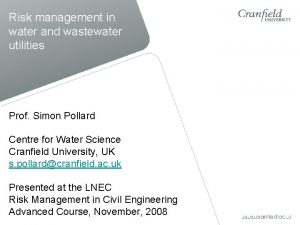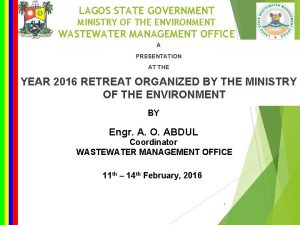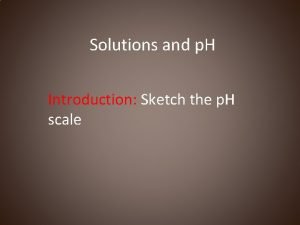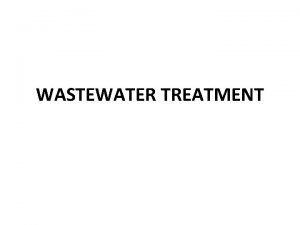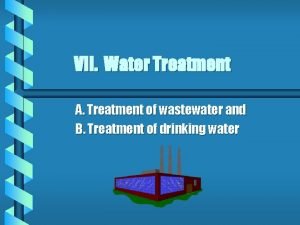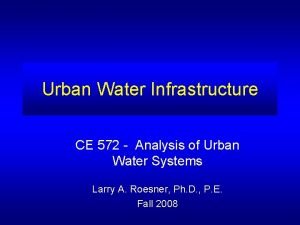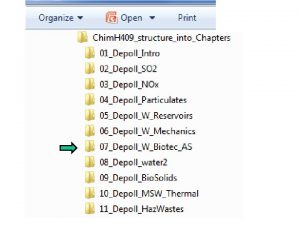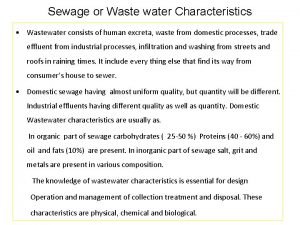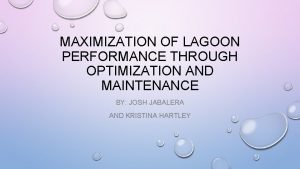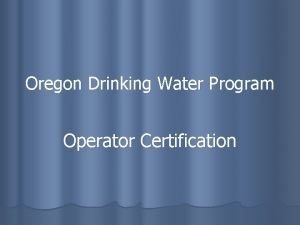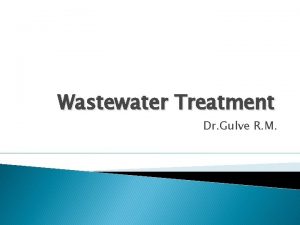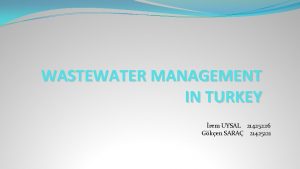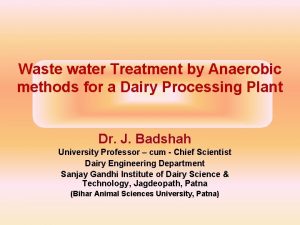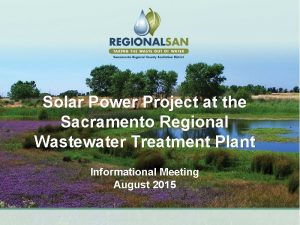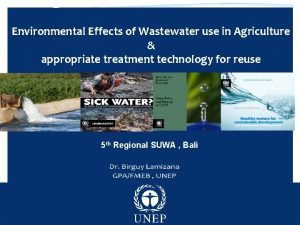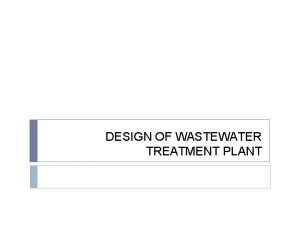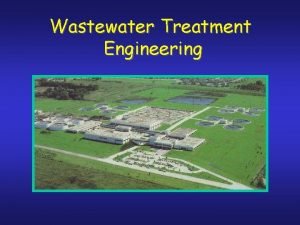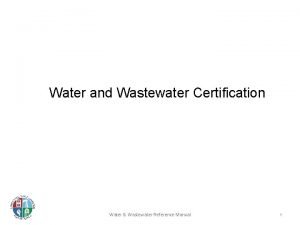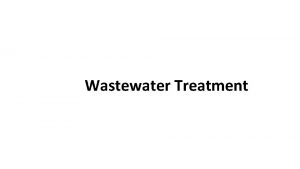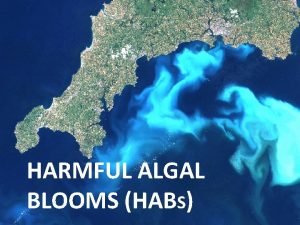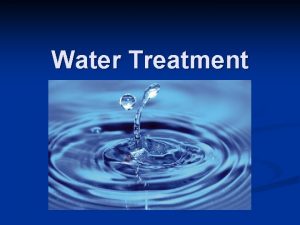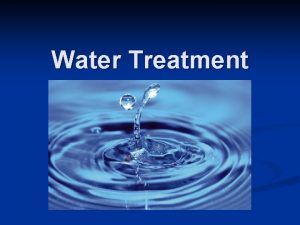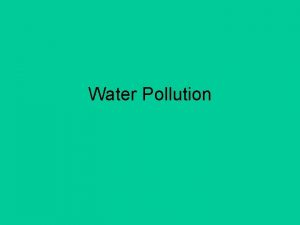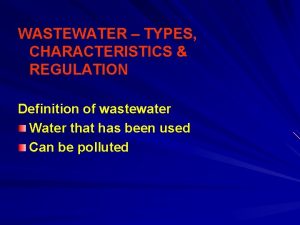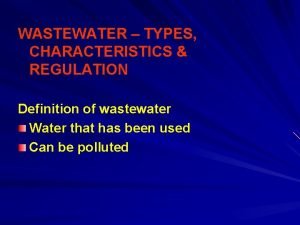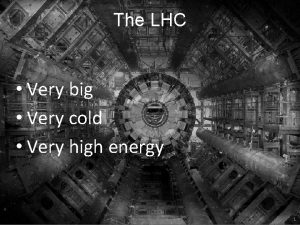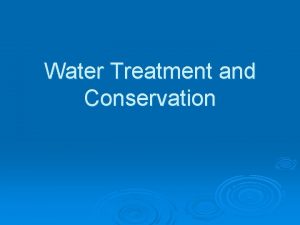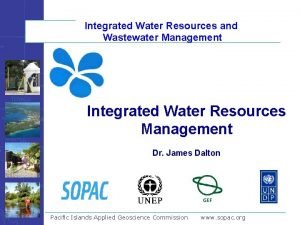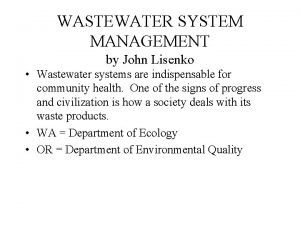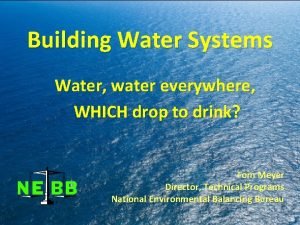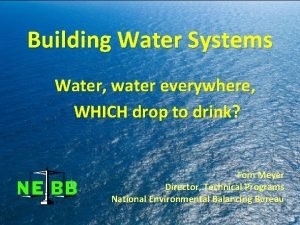Wastewater Management Wastewater Water which is very harmful



























- Slides: 27

Wastewater Management

Wastewater • Water, which is very harmful to the environment is called wastewater • Wastewater can be contaminated with a myriad of different components : pathogens, organic compounds, synthetic chemicals, nutrients, organic matter and heavy metals. https: //www. flickr. com/photos/oddsock/9756106243

Sources • Domestic Wastewater • Industrial activities • Commercial activities • Agricultural activities • Surface runoff or storm water • Infiltration.

Domestic wastewater • Sources : Kitchen , Bath rooms and Toilet • Types : Grey wastewater Water coming after using it from Kitchen and bathroom Black wastewater The waste water generating from the toilets called black water will contain urine and faecal sludge. commons. wikimedia. org

Collection and Transport of wastewater • Sewerage system The system of collecting wastewater from each waster water sources and transport to waste water treatment plant. Two methods of conveyance: Ø The separate sewerage system Collecting and convey wastewater and storm water separate pipe lines. Ø The combined sewerage system wastewater and storm water both are conveying in same pipe lines.

Collection and Transport of wastewater Separate Sewer system Combined sewer system http: //winnipeg. ca/waterandwaste

Collection and Transport of wastewater Combined sewerage system Separate sewerage system Øpipes that convey domestic sewage, industrial wastewater and storm water runoff. ØEnvironmentally friendly and comfortable for user ØSeparate sewer systems are designed to convey wastewater and storm water in separate pipes ØSanitary sewer systems collect and transport wastewater ØStorm sewer systems collect and transport storm water runoff

Combined sewerage system Advantages Disadvantages Do not require on-site pre-treatment or storage of the The initial cost is high wastewater Suitable for urban areas Maintenance costs are high consists mainly inspection, unblocking and repair Storm water and wastewater can be managed at the same time Extension of the system can be difficult and costly Convenience method Recycling of nutrients and energy becomes difficult Need skill personals

Separate sewerage system Advantages Disadvantages Grey and black water can manage separately from Surface run off High capital costs, more expensive than combined sewer system Limited risk of sewage flow Requires skilled engineers and operators Can consider use of storm water Problems associated with blockages and breakdown of pumping equipment Moderate operation costs Adequate treatment and/or disposal required for a large point source discharge

Sewerage system – Design Aspects Gravity sewerage conveyance system http: //www. sewerhistory. org/

Sewerage system – Design Aspects • Design capacity and design flow Sewer capacities shall be designed for the estimated ultimate tributary population The capability of downstream sewers to accept future flow made tributary to the collection system shall be evaluated by the engineer. • Design parameters 1. Size of the pipe 2. Depth of the pipe line 3. Slope for gravity lines

Sewerage system – Design Aspects •

Sewerage system – Design Aspects Manholes ü Manholes shall be installed: at the end of each line, at all changes in grade, size, or alignment, at all intersections, and at distances required in the specifications. üDrop manholes should be constructed with an outside drop connection. Inside drop connections (when necessary) shall be secured to the interior wall of the manhole and access shall be provided for cleaning. http: //www. msdlouky. org/

Sewerage system – Design Aspects Pressure sewerage conveyance system ü This system should have pump in every houses ü Expensive www. dlsweb. rmit. edu. au

Sewerage system – Design Aspects Pressure sewerage conveyance system üPressurised sewers differ from conventional gravity collection systems, because they use pumps instead of gravity to transport wastewater üThe primary effluent is delivered to the collection tank by gravity where it is pressed before being transported into the pressurised system by pumps üIt is an effective solution where conventional systems are impractical such as in rocky, hilly or densely populated areas or areas with a high groundwater table www. dlsweb. rmit. edu. au

Sewerage system – Design Aspects • Introduction to EPA-NET software

Wastewater Management Wastewater management should consider the sustainable management of wastewater from source to re-entry into the environment. Waste water management approaches can be decided by considering on, whether the area is urban or rural, the size and density of the population, level of economic development, technical capacity and system of governance in place

Waste water Management • Reuse Relatively clean water such as Bathing and Kitchen waste water can reuse without treatment for Irrigation and Flushing toilets. • Recycle Wastewater can be reuse for non-drinking purposes after treatment (onsite or off site) Closed loop treatment system – Wastewater should collect, treat and reuse on-site Wastewater reclamation – Treated wastewater use for different purposes

Waste water Management • Treat and Discharge Wastewater can be collect , treat and discharge into the any natural water body without harmful to the environment. üCentralized wastewater treatment facility collect wastewater from many users for treatment at one or few sites üDecentralized wastewater treatment facility Generally this is on-site systems, collecting and treating wastewater from individual users or small clusters of users at the neighborhood or small community level.

Centralized and Decentralized system http: //webapps. icma. org/

Centralized treatment system • Conventional gravity sewers • One centralized wastewater treatment facility for certain area • Effluent discharge directly to surface water • High capital cost for construction • Transfers water away from source basin, so leakage problems etc. • Long, disruptive construction • Skilled persons need to design and maintenance • Potential for catastrophic failure

Decentralized treatment system • Onsite or cluster systems • Multiple treatment and soil dispersal or reuse facilities • Low-cost, shallow sewer systems for clusters • Lower capital costs • Keeps water close • Short, less-disruptive construction • Basic operation skills required • Failure consequences felt in smaller area

Waste water as a Resource Reuse of wastewater depends on the individual household waste management practices such as separation of urine and faecal matters. Application of wastewater as a resource, • drought-resistant source of water (especially for agriculture or industry) • source of nutrients for agriculture • soil conditioner • source of energy/heat.

Wastewater as a resource of Agriculture • Wastewater treatment and reuse in agriculture can provide benefits to farmers in conserving fresh water resources, improving soil integrity, preventing discharge to surface and groundwaters. • Typical concentrations of nutrients in treated wastewater effluent from conventional sewage treatment processes are as follows: 50 mg/litre of nitrogen; 10 mg/litre of phosphorus 30 mg/litre of potassium.

Advantages of Wastewater Management • Wastewater management has many associated environmental benefits, enabling ecosystems within watersheds the productive coastal zone to thrive and deliver services on which healthy communities and economies depend. • Inadequate management in turn incurs heaving costs, threatening to undermine these ecosystems.

Challenges Problems related to wastewater Wastewater as a Resource

Acknowledgement • “Minimum Design Criteria for the permitting of Gravity Sewers “ Adopted by the Division of Water Quality on February 12, 1996, Updated to 15 A NCAC 2 T Regulations on March 2008. • “Type of Sewer Systems “, Solomon Seyoum • “ Waste water Management” , PLTW • “Wastewater Management A UN-Water Analytical Brief”
 Household materials useful or harmful
Household materials useful or harmful Water and water and water water
Water and water and water water Risk management for water and wastewater utilities
Risk management for water and wastewater utilities Figure 10
Figure 10 Scientific notation rules
Scientific notation rules There is very few soup in the bowl
There is very few soup in the bowl Is a very shallow skillet with very short sloping sides
Is a very shallow skillet with very short sloping sides Quantifiers with food
Quantifiers with food Lagos state wastewater management office
Lagos state wastewater management office Seltzer water and sodas contain a very mild
Seltzer water and sodas contain a very mild Purpose of wastewater treatment
Purpose of wastewater treatment Aquaculture characteristics
Aquaculture characteristics Wastewater treatment process primary secondary tertiary
Wastewater treatment process primary secondary tertiary Wastewater distribution system
Wastewater distribution system Typical composition of untreated domestic wastewater
Typical composition of untreated domestic wastewater Characteristics of sewage
Characteristics of sewage Optimize wastewater lagoon
Optimize wastewater lagoon Ashbridges bay wastewater treatment plant
Ashbridges bay wastewater treatment plant Oregon water treatment certification
Oregon water treatment certification Peak flow average
Peak flow average Municipal wastewater treatment
Municipal wastewater treatment Agricultural wastewater treatment technologies
Agricultural wastewater treatment technologies Anaerobic wastewater treatment
Anaerobic wastewater treatment Wastewater infrastructure design in texas
Wastewater infrastructure design in texas Sacramento regional wastewater treatment plant
Sacramento regional wastewater treatment plant Agricultural wastewater treatment technologies
Agricultural wastewater treatment technologies Rectangular primary clarifier
Rectangular primary clarifier Secondary wastewater treatment
Secondary wastewater treatment


